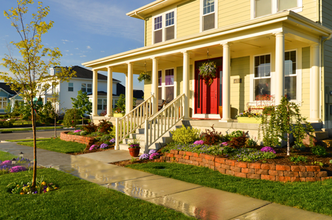 Destination Homes' mission is to build exceptional homes in lasting communities. Working with world-class architects & skilled trade partners, Destination Homes aims continually to be a product leader in community design & residential architecture. There are a few things in life that are better backward - like The Beatles songs that reveal cryptic messages when played back, or roller coasters that get just a little scarier when they lurch into reverse. And don't forget the excellent benefits you give your quads when you (carefully) do a little backward running. But do you know what's not better backward? Your neighborhood. If you're not sure how topsy-turvy your own community might be, we'll give you a few tell-tale signs.
Destination Homes' mission is to build exceptional homes in lasting communities. Working with world-class architects & skilled trade partners, Destination Homes aims continually to be a product leader in community design & residential architecture. There are a few things in life that are better backward - like The Beatles songs that reveal cryptic messages when played back, or roller coasters that get just a little scarier when they lurch into reverse. And don't forget the excellent benefits you give your quads when you (carefully) do a little backward running. But do you know what's not better backward? Your neighborhood. If you're not sure how topsy-turvy your own community might be, we'll give you a few tell-tale signs.
The cars (and garages) are the stars of the show
Have you ever seen a house that seems to be "all garage?" Not overly appealing, right? Your neighborhood may have been designed poorly (dare we say backwardly?) if your cars seem to be getting better architectural treatment than your family. Giant garages that monopolize your home's curb appeal and commandeer your lawn space with their oversized driveways are not designed with family living in mind. Your home should be taking center stage - not your garage (that prima donna)
Picket fences are nostalgic and picturesque. But if you've got a monstrosity of a gate that's turning your Craftsman-style home into a medieval fortress, you may be living in a poorly designed community. Privacy is always a bonus, but you should also feel connected with the community that surrounds you. This includes a better view than the wood planks that make up your mile-high fence. Don't get me wrong, a fence serves its purpose but shouldn't keep you from enjoying what's around you. It also means that your home should be facing the world of the living, not a concrete barrier, frontage road or other unsightly "feature."
Have you ever seen a house that seems to be "all garage?" Not overly appealing, right? Your neighborhood may have been designed poorly (dare we say backwardly?) if your cars seem to be getting better architectural treatment than your family. Giant garages that monopolize your home's curb appeal and commandeer your lawn space with their oversized driveways are not designed with family living in mind. Your home should be taking center stage - not your garage (that prima donna)
Picket fences are nostalgic and picturesque. But if you've got a monstrosity of a gate that's turning your Craftsman-style home into a medieval fortress, you may be living in a poorly designed community. Privacy is always a bonus, but you should also feel connected with the community that surrounds you. This includes a better view than the wood planks that make up your mile-high fence. Don't get me wrong, a fence serves its purpose but shouldn't keep you from enjoying what's around you. It also means that your home should be facing the world of the living, not a concrete barrier, frontage road or other unsightly "feature."
You feel like you're living in "Mario Kart"
It's one thing for your kids to encounter crazy traffic with Mario and Luigi on the Wii, it's quite another for them to have to deal with this in front of your home. High-volume roads with intersections tend to make your sanctuary a little, well, less than idyllic.
Communities built on heavily trafficked roads are not designed with homeowners and their families in mind. Families want safety at the forefront of their neighborhood planning. Besides safety, many could use fewer barriers to hurdle to when the desire strikes to visit neighbors, get to church, or go to the local park.
Like many people, you're probably thrilled that your community offers walking trails (and your dog likely digs this feature, too). But if your trails are hidden, dimly lit or overgrown, that's a sign that your community likely wasn't designed as well as it could have been. Hidden trails pose not only a safety risk, but they also prevent you from connecting with your community when you take that daily walk (although Fido might enjoy his privacy).
It's one thing for your kids to encounter crazy traffic with Mario and Luigi on the Wii, it's quite another for them to have to deal with this in front of your home. High-volume roads with intersections tend to make your sanctuary a little, well, less than idyllic.
Communities built on heavily trafficked roads are not designed with homeowners and their families in mind. Families want safety at the forefront of their neighborhood planning. Besides safety, many could use fewer barriers to hurdle to when the desire strikes to visit neighbors, get to church, or go to the local park.
You feel disconnected from the community
There are a lot of benefits to living on an island (mid-morning swim anyone?), but if you're looking to be part of a community, you don't want to feel like your home is centrally located in the Boondocks. Your neighborhood should be designed in a way that connects resident families to their surroundings by strategically designing the homes around parks, community centers and other amenities. After all, the layout of any neighborhood just might be the key to connecting community members naturally.

There are a lot of benefits to living on an island (mid-morning swim anyone?), but if you're looking to be part of a community, you don't want to feel like your home is centrally located in the Boondocks. Your neighborhood should be designed in a way that connects resident families to their surroundings by strategically designing the homes around parks, community centers and other amenities. After all, the layout of any neighborhood just might be the key to connecting community members naturally.



